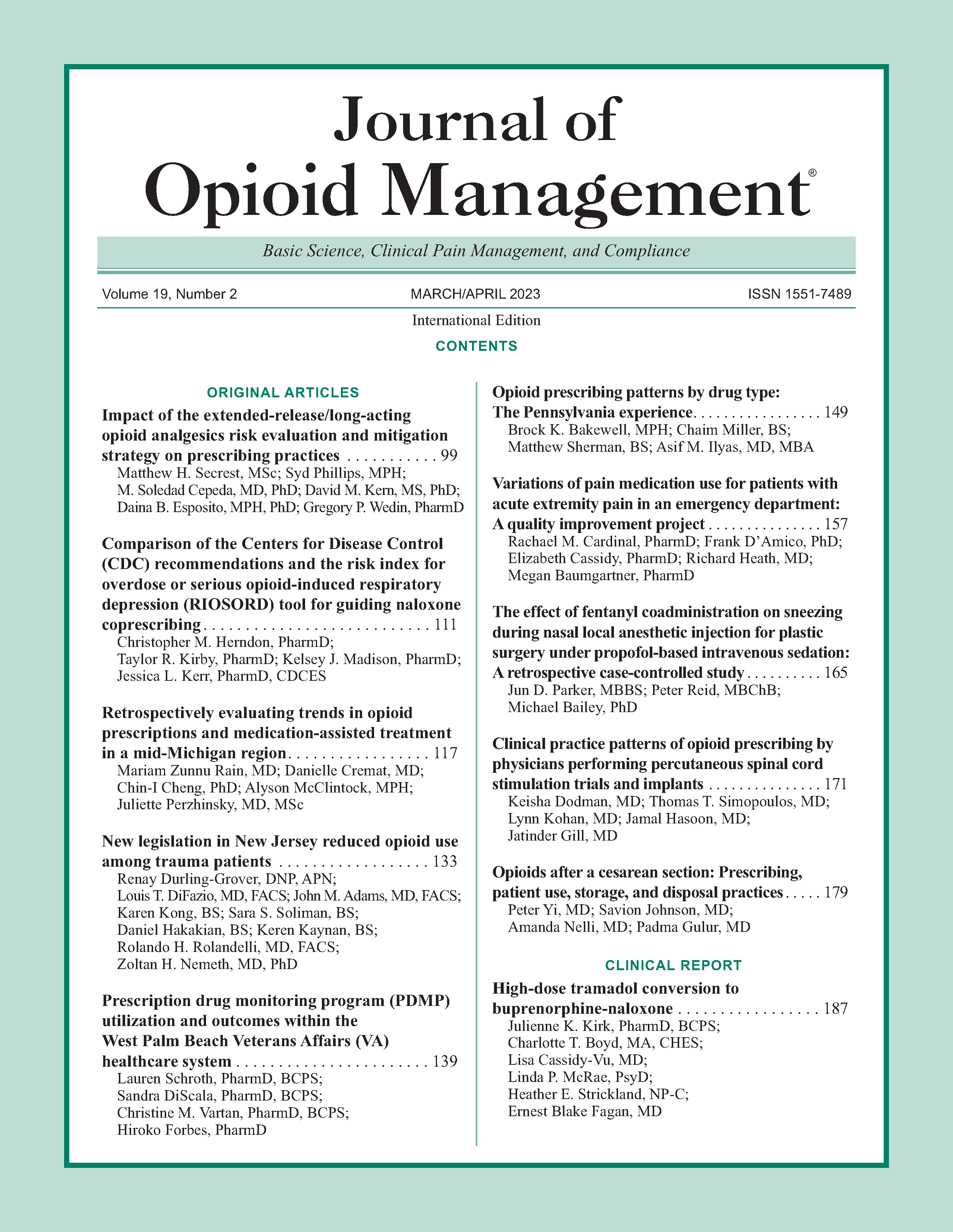Comparison of the Centers for Disease Control (CDC) recommendations and the risk index for overdose or serious opioid-induced respiratory depression (RIOSORD) tool for guiding naloxone coprescribing
DOI:
https://doi.org/10.5055/jom.2023.0765Keywords:
RIOSORD, opioid overdose, risk mitigation, naloxone, opioidAbstract
Purpose: Patients treated with ongoing opioid therapy may be at an increased risk of respiratory depression or death, which may be mitigated through prompt administration of naloxone. The Centers for Disease Control (CDC) guidelines for prescribing opioids in primary care settings recommend patients treated with ongoing opioid analgesic therapy be offered a coprescription of naloxone based on total oral morphine milligram equivalents per day or concurrent benzodiazepine therapy. Opioid overdose risk is dose-dependent, yet other patient-specific factors contribute to this risk. The risk index for overdose or serious opioid-induced respiratory depression (RIOSORD) incorporates additional risk factors to assess the risk of overdose or clinically relevant respiratory depression.
Objectives: This study compared the frequency of meeting CDC, Veterans’ Health Administration (VA) RIOSORD, or civilian RIOSORD criteria for naloxone coprescribing.
Methods: A retrospective chart review of 42 Federally Qualified Health Centers in Illinois was conducted for all CII-CIV opioid analgesic prescriptions. Ongoing opioid therapy was defined as patients who received seven or more CII-CIV opioid analgesic prescriptions during the 1-year study period. Patients aged 18-89, receiving opioids for nonmalignant pain, and meeting the criteria of ongoing opioid therapy were included in the analysis.
Results: A total of 41,777 controlled substance analgesic prescriptions were prescribed during the study period. Data from 651 individual patient charts were evaluated. Of those, 606 patients met inclusion criteria. From these data, 57.9 percent of patients (N = 351) met civilian RIOSORD criteria, 36.5 percent (N = 221) met VA RIOSORD criteria, and 22.8 percent (N = 138) met CDC guideline recommendations for naloxone coprescribing. The percentage of patients who met RIOSORD criteria compared to CDC criteria was significantly higher (p < 0.001). Of all patients meeting ongoing opioid therapy criteria, only seven had been coprescribed naloxone.
Conclusion: Coprescribing of naloxone is significantly underutilized in patients treated with opioid therapy for nonmalignant chronic pain and should not solely be based on total oral morphine milligram equivalents per day or concurrent benzodiazepine therapy. As risk assessment improves, consideration of other risk-conferring variables, such as gabapentinoids, skeletal muscle relaxants, and sleep hypnotics, should be considered.
References
Hoopsick RA, Homish GG, Leonard KE: Differences in opioid overdose mortality rates among middle-aged adults by race/ ethnicity and sex, 1999-2018. Public Health Rep. 2021; 136(2): 192-200. DOI: 10.1177/0033354920968806.
Ciccarone D: The rise of illicit fentanyls, stimulants and the fourth wave of the opioid overdose crisis. Curr Opin Psychiatry. 2021; 34(4): 344-350. DOI: 10.1097/YCO.0000000000000717.
Stephenson J: CDC warns of surge in drug overdose deaths during COVID-19. JAMA Health Forum. 2021; 2(1): e210001. DOI: 10.1001/jamahealthforum.2021.0001.
Mattson CL, Tanz LJ, Quinn K, et al.: Trends and geographic patterns in drug and synthetic opioid overdose deaths—United States, 2013–2019. MMWR Morb Mortal Wkly Rep. 2021; 70(6): 202-207. DOI: 10.15585/mmwr.mm7006a4.
Dowell D, Haegerich TM, Chou R: CDC guideline for prescribing opioids for chronic pain–United States, 2016. JAMA. 2016; 315(15): 1624-1645. DOI: 10.1001/jama.2016.1464.
Zedler B, Xie L, Wang L, et al.: Development of a risk index for serious prescription opioid-induced respiratory depression or overdose in veterans’ health administration patients. Pain Med. 2015; 16(8): 1566-1579. DOI: 10.1111/pme.12777.
Zedler BK, Saunders WB, Joyce AR, et al.: Validation of a screening risk index for serious prescription opioid-induced respiratory depression or overdose in a US commercial health plan claims database. Pain Med. 2018; 19: 68-78. DOI: 10.1093/pm/pnx009.
Metcalfe L, Murrelle EL, Vu L, et al.: Independent validation in a large privately insured population of the risk index for serious prescription opioid-induced respiratory depression or overdose. Pain Med. 2020; 21(10): 2219-2228. DOI: 10.1093/PM/PNAA026.
Barenie RE, Gagne JJ, Kesselheim AS, et al.: Rates and costs of dispensing naloxone to patients at high risk for opioid overdose in the United States. Drug Safety. 2014; 43(7): 2018. DOI: 10.1007/s40264-020-00923-6.
Evoy KE, Hill LG, Davis CS: Considering the potential benefits of over-the-counter naloxone. Integr Pharm Res Pract. 2021; 10: 13-21. DOI: 10.2147/IPRP.S244709.
Chun KLJ, Olsen A, Taing M-W, et al.: How prepared are pharmacists to provide over-the-counter naloxone? The role of previous education and new training opportunities. Res Soc Adm Pharm. 2019; 15(8): 1014-1020. DOI: 10.1016/J.SAPHARM.2019.03.003.
Jones CM, Compton W, Vythilingam M: Naloxone coprescribing to patients receiving prescription opioids in the Medicare part D program, United States, 2016-2017. JAMA. 2019; 322(5): 462-464. DOI: 10.1001/JAMA.2019.7988.
Cohen BR, Mahoney KM, Baro E, et al.: FDA initiative for drug facts label for over-the-counter naloxone. N Engl J Med. 2020; 382(22): 2129-2136. DOI: 10.1056/nejmsa1912403.
Gomes T, Mamdani MM, Dhalla IA, et al.: Opioid dose and drug-related mortality in patients with nonmalignant pain. Arch Intern Med. 2011; 171(7). DOI: 10.1001/archinternmed.2011.117.
Dunn KM, Saunders KW, Rutter CM, et al.: Opioid prescriptions for chronic pain and overdose: A cohort study. Ann Intern Med. 2010; 152(2): 85. DOI: 10.7326/0003-4819-152-2-201001190-00006.
Zhou L, Bhattacharjee S, Kwoh CK, et al.: Dual-trajectories of opioid and gabapentinoid use and risk of subsequent drug overdose among Medicare beneficiaries in the United States: A retrospective cohort study. Addiction. 2021; 116(4): 819-830. DOI: 10.1111/add.15189.
Park TW, Lin LA, Hosanagar A, et al.: Understanding risk factors for opioid overdose in clinical populations to inform treatment and policy. J Addict Med. 2016; 10(6): 369-381. DOI: 10.1097/ADM.0000000000000245.
Li Y, Delcher C, Wei YJJ, et al.: Risk of opioid overdose associated with concomitant use of opioids and skeletal muscle relaxants: A population-based cohort study. Clin Pharmacol Therap. 2020; 108(1). DOI: 10.1002/cpt.1807.
Palumbo SA, Adamson KM, Krishnamurthy S, et al.: Assessment of probable opioid use disorder using electronic health record documentation. JAMA Netw Open. 2020; 3(9): e2015909. DOI: 10.1001/jamanetworkopen.2020.15909.
Published
How to Cite
Issue
Section
License
Copyright 2005-2025, Weston Medical Publishing, LLC and Journal of Opioid Management. All Rights Reserved.











